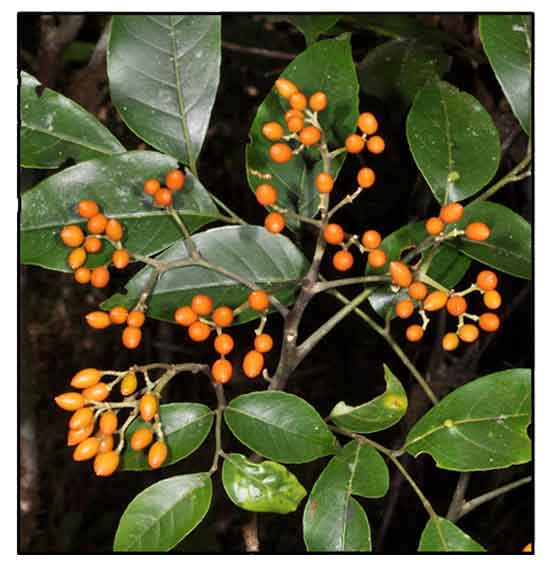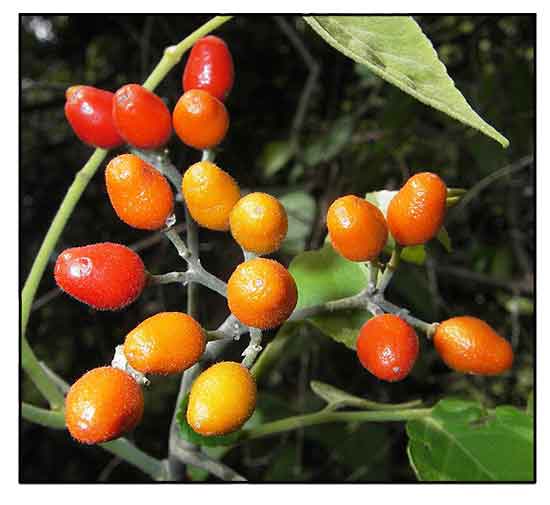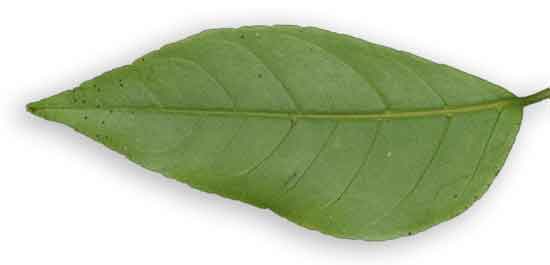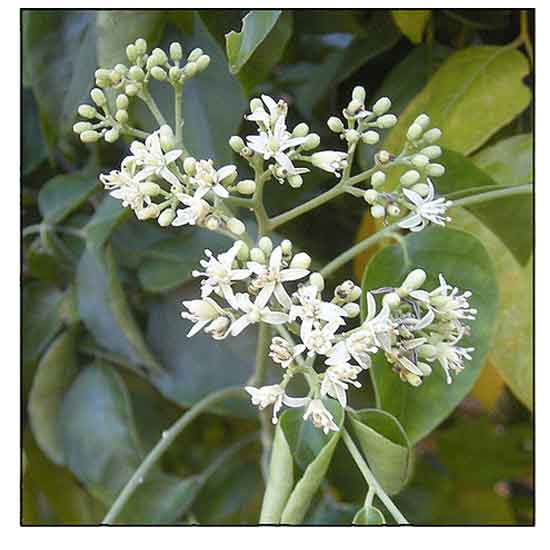 Gen info Gen info
- Micromelum is a genus of eight species of flower plants in the family Rutaceae. It includes 8 species.
- The genus was first described in 1825 by Carl Ludwig Blume in Bijdragen tot de Flora van Nederlandsch Indie. (2)
- Limeberry was first formally described in 1786 by Georg Forster, initially names Limonia minuta. In 1834, Wight and George Arnott Walker-Arnott changed the name to Micromelum minutum in their book Prodromus Florae Peninsulae Indiae Orientalis. (3)
Botany
• Micromelum minutum is a tree that typically grows to a height of 10–20 m (33–66 ft) but also flowers and forms fruit as a dense shrub. The leaves are up to 300 mm (12 in) long and pinnate with seven to fifteen egg-shaped to lance-shaped leaflets 30–120 mm (1.2–4.7 in) long and 15–60 mm (0.59–2.36 in) wide on a petiolule up to 5 mm (0.20 in) long. The flowers are borne in large, hairy, scented groups 130–200 mm (5.1–7.9 in) long, each flower on a pedicel up to 5 mm (0.20 in) long. The petals are pale green or creamish, 5–8 mm (0.20–0.31 in) long and there are ten stamens that alternate in length. Flowering occurs all year and the fruit a yellow to orange or red, oval to spherical berry about 10 mm (0.39 in) long. (3) Flowers are small and white, blooming in fragrant clusters. Fruits are ellipsoid, about 1 cm long, with a thin berry-like skin, and one seeded.
Distribution
- Native to the Philippines.
- Found throughout the Philippines.
- Also native to Assam, Bangladesh, Cambodia, Caroline Is., China, Fiji, Hainan, Laos, Lesser Sunda Is., Malaya, Myanmar, New Caledonia, Niue, Samoa, Solomon Is., Sri Lanka, Thailand, Tonga, Vanuatu, Vietnam, Wallis-Futuna Is.
(1)
 Constituents Constituents
- Assay-guided isolation of M. minutum leaves purified two new monoterpene coumarins, minutin A and B, together with four known coumarins, 8,4″-dihydroxy-3″,4″-dihydrocapnolactone-2′,3′-diol, 8-hydroxyisocapnolactone-2′,3′-diol, 8-hydroxy-3″,4″-dihydrocapno-lactone-2′,3′-diol, and clauslactone E. (see study below) (4)
- Fractionation of crude petroleum ether and chloroform extracts isolated five new coumarins 3″,4″-dihydrocapnolactone, 2′,3′-epoxyisocapnolactone, 8-hydroxyisocapnolactone-29,39-diol, 8-hydroxy-3″,4″-dihydrocapnolactone-29,39-diol and 8,4″-dihydroxy-3″,4″-dihydrocapnolactone-29,39-diol, and two triterpenes. (see study below) (5)
- Study of aerial parts of M. minutum isolated three new glucosides of phenylpropanoic acid derivatives (micromelumosides A–C) and a new coumarin glucoside (micromelumoside D) were isolated from the aerial portions of Micromelum minutum in addition to 15 known compounds, 3,4-dihydro-1,2-secomicrominutinin 9-O-β-d-glucopyranside, umbelliferone-7-O-α-l-rhamnopyranosyl-(1 → 6)-β-d-glucopyranoside, scopolin, haploperoside A, (S)-peucedanol 7-O-β-d-glucopyranoside, (R)-peucedanol 7-O-β-d-glucopyranoside, decuroside V, 4-hydroxy-2,6-dimethoxyphenyl 4-O-β-d-glucopyranoside, vanilloloside, 3,5-dimethoxybenzyl alcohol 4-O-β-d-glucopyranoside, (+)-lyoniresinol 3α-O-β-d-glucopyranoside, (+)-syringaresinol 4-O-β-d-glucopyranoside, kaempferol 3-O-sophoroside, kaempferol 3-O-rutinoside, and citroside B. (9)
- Study of M. minutum yielded four known coumarins (osthol, micromelin, murralongin, and murrangatin) and five new coumarins, dihydromicromelin A and B, acetyldihydromicromelin A, the threo diastereomer of murrangatin, the 7,12-ether of 5,7-dihydroxy-3,6,8,4′-tetramethoxyfiavone and murrangatin. (10)
 - Nutritional composition study of leaves (g/100g) yielded 70.4 moisture, 2.0 ash, 14.0 protein
, 2.3 fat content, 11 carbohydrate content. Phytochemical screening of leaves yielded alkaloids, flavonoids, unsaturated steroids, triterpenes, tannins, with absence of saponins. (12) - Nutritional composition study of leaves (g/100g) yielded 70.4 moisture, 2.0 ash, 14.0 protein
, 2.3 fat content, 11 carbohydrate content. Phytochemical screening of leaves yielded alkaloids, flavonoids, unsaturated steroids, triterpenes, tannins, with absence of saponins. (12)
- Study of fruits isolated a new 7-oxygenated coumarin, 7-demethylmurralonginol isovalerate (1), and a new natural product, murralonginol (2), together with seven known 7-oxygenated coumarins, murralonginol isovalerate (3), murralongin (4), micromelin (5), scopoletin (6), microminutin (7), murrangatin (8), and minumicrolin (9). (see study below) (13)
- Study of roots isolated a new coumarin, minutuminolate (1), together with 11 known coumarins (2-12). (see study below) (17)
- Anti-Leishmania major assay-guided study of leaves isolated two new monoterpene coumarins, named minutin A and minutin B, together with four known coumarins, 8,4′′-dihydroxy-3′′,4′′-dihydrocapno lactone-2′,3′diol, 8-hydroxyisocapnolactone-2′,3′- diol, 8-hydroxy-3′′,4′′-dihydrocapnolactone-2′,3′-diol, and clauslactone E. (see study below) (20)
- Study of leaves for essential oil yielded major components of sesquiterpenes δ-elemene (3.3–18.6%), β-caryophyllene (4.8–30.3%), germacrene-D (2–15.8%) and germacrene-B (3.9–34.3%). (22)
Properties
- Studies have suggested antimicrobial, cytotoxicity, anticancer, antileishmanial, antioxidant, antimutagenicity, antimalarial, apoptotic, insecticidal. antihyperglycemic. antihyperlipidemic, anti-rancidity properties.
Parts used
Leaves, shoots, roots, bark.
 Uses Uses
Edibility
- In Thailand, shoots are used as fresh vegetables.
- Used as flavoring agent.
- Ripe sour berries are are edible, fresh, cooked, or preserved.
Folkloric
- In the Philippines, indigenous communities in Esperanza, Agusan del Sur, use leaves, roots, and stems for treatment of cancer, cuts and wounds, diarrhea, muscle pain, poisoning, skin diseases, snakebite, and stomach troubles. (23) Young shoots are heated with oil and used as medicine for infantile convulsions. Roots used for toothache.
(27)
-
In Malaysia, used for treatment of fever and ringworm. (2) Plant used for treatment of malaria and other infectious diseases. (13)
- In Thailand, leaves used for fever and dizziness. (4) Kaloeng ethnic group use decoction of boiled roots for bathing to stimulate blood circulation. Steam from boiled roots and leaves used to relieve headache. (25)
- Poultice of boiled roots applied to treat ague. In Indochina, roasted and crushed leaves are rubbed on to skin irritated by scabies; leaves also used as emmenagogue. (5)
- Roots used for treating ringworm, tumors, fever, and to regulate menstruation. Leaves and bark used to treat toothache and teething issues in babies, skin irritation cause by scabies, and to treat stomachaches and headaches. Roots decoction or infusion used as carminative and to treat diarrhea in children. (12)
- In Malaysia, leaves traditionally used as febrifuge, stems as carminative, flowers as expectorant, and fruits as purgative. (26)
- In southern Sumatra, roots chewed with betel for treatment of coughs. In Fiji, leaves or inner bark of twigs used for headache and stomachache, coughs, sore tongue; to arrest heavy menstruation, treat gonorrhea, and as remedy for thrush. (27)
Others
- Ecology: A food source for some species of butterfly viz. the orchard butterfly (Papilio aegeus) and canopus butterfly (Papilio fuscus). (3)
- Wood: In Malesia and Indonesia, used for construction. Also used for furniture and tool handles.
- Superstition: Plant believed to have magical powers in warding off evil spirits.
Studies
• Anti-Leishmanial / Anticancer / Coumarins / Leaves: Assay-guided isolation of M. minutum leaves purified two new monoterpene coumarins, minutin A and B, together with four known coumarins. Minutin A and B and two of the known compounds showed significant cytotoxic activity against Leishmania major with IC50 of 26.2, 20.2, 12.1 and 9.8 µM, respectively. All the compounds exhibited inhibitory activity against one or more lung adenocarcinoma (SBC3 and A549) and leukemia (K562 and K562/ADM) cell lines. Clauslactone E, minutin B and 8-hydroxyisocapnolactone-2′,3′-diol showed strongest cytotoxic activity against SBC3, A549, K562, and K562/ADM cell lines. (see constituents above) (4)
• Coumarins / Cytotoxic Activity against Cancer Cell Lines: Crude petroleum ether and chloroform extracts of M. minutum showed strong cytotoxic activity against T-lymphoblastic leukemia cell line. Further fractionation isolated five new coumarins. Some compounds were strongly active against T-lymphoblastic leukemia (CEM-SS), promyelocytic leukemia (HL60), cervical cancer (HeLa) and liver cancer (HepG2) cell lines. (see constituents above) (5)
• Antimutagenicity / Cytotoxicity / Antimicrobial / Mahanine: Study evaluated methanolic extracts of 118 samples of edible Thai plants for antimutagenic activity against Trp-P-1. Five plants exhibited significant activity with antimutagenic ED90 values < 5 µL/plat (0.1 mg of dry plant material equivalent), of which M. minutum exhibited highest antimutagenic activity. Guided fractionation of M. minutum isolated an active principle, (+)-mahanine (1), which showed a wide variety of biological activity, including antimutagenicity against heterocyclic amines such as Trp-P-1 with IC50 of 5.2 µM, cytotoxicity against HL50 cell line with MIC100 of 4.0/mL, and antimicrobial activity against Bacillus cereus and Staphylococcus aureus with MIC100 of 6.25 and 12.5 µg/mL, respectively. (6)
• Antioxidant / Bark: Study evaluated the antioxidant activity of M. minutum bark extract and active fractions. Results showed significant antioxidant activity with IC50 of 54.3 and 168.9 µg/mL respectively. Hydramicromelinin was identified from the active fraction as a potential lead of an antioxidant compound. (7)
• Cytotoxicity towards Breast Cancer Cell Line / MCF-7 and 4T1 Cancer Cells / Leaves: Study evaluated the cytotoxic activity of Indonesian M. minutum leaf extracts towards MCF-7 and 4T1 breast cancer cell lines. A hexane extract was the most active, with IC50s of 148 and 87 µg/mL on MCF7 and 4T1 cells. (8) n-Hexane and ethyl acetate extracts contained a flavonoid 5,7-dihydroxy-3,4',8-trimethoxyflavone (1) which inhibited MCF-7 and 4T1 cell viability by 50% at concentrations of 369±8 and 227±5 µM, respectively. (15)
• Antioxidant / Bark: PTLC-DPPH study of a methanol bark extract isolated a lignan sesamin (1), two prenylated coumarins (2 and 3) and a marmesin glycosides (4). The methanol extract and fraction showed DPPH radical scavenging activity with IC50s of 54.3 and 168.9 µg/ml, and ß-carotene bleaching activity of 55.19 and 5.75% respectively. On ORAC measurements, compounds 2 and 4 showed potent antioxidant activity with 5123, 5539, and 4031 µmol TE/g respectively. (11)
• Oxygenated Coumarins / Cytotoxicity against Cholangiocarcinoma Cell Line / Fruits: Study of fruits isolated a new 7-oxygenated coumarin, 7-demethylmurralonginol isovalerate (1), and a new natural product, murralonginol (2), together with seven known 7-oxygenated coumarins, murralonginol isovalerate (3), murralongin (4), micromelin (5), scopoletin (6), microminutin (7), murrangatin (8), and minumicrolin (9). Compounds 2 and 4-9 exhibited cytotoxicity against cholangiocarcinoma cell line, KKU-100. (13)
• Antiplasmodial / 8-Hydroxyisocapnolactone-2',3'-diol: The coumarin 8-hydroxyisocapnolactone-2',3'-diol has been isolated from the plant and has shown cytotoxic activity. Study evaluated the in vitro antiplasmodial activity of the coumarin against chloroquine-resistant (FCR-3) and chloroquine-sensitive (D-10) Plasmodium falciparum. Results showed 8-hydroxyisocapnolactone-2',3'-diol has in vitro antiplasmodial activity against FCR-3 and D-10 with IC50s of 6.39 µg/mL (16.99 µM) and 24.23 µg/mL (64.45 µM), respectively. (14)
• Insecticidal against C. maculatus / Leaf Essential Oil: The bruchid, Callosobruchus maculatus causes major losses during storage of cowpea seeds Vigna unguiculata in Sri Lanka. Study evaluated essential oils M. minutum leaves and Cinnamomum zeylanicum fruits for insecticidal activity against C. maculatus. The adults of C. maculatus were susceptible to both fumigant and contact toxicity of Cz fruit and Mm leaf oil. In fumigant toxicity assay, M. minutum leaf oil showed lower LC50 of 0.801 g/L. Contact toxicity for Mm showed LC50 of 0.071 g/L. Oviposition and F1 adult emergence were significantly inhibited by Mm leaf oil at concentration higher than 0.25 g/L. Repellent activity of Mm leaf oil to C. maculatus was more potent. Oil analysis showed major constituent of Mm leaf oil was bicyclogermacene (16.0%). (16)
• Coumarin / Cytotoxicity against KB Cell Line / Roots: Study of roots isolated a new coumarin, minutuminolate (1), together with 11 known coumarins (2-12). Compounds 2, 5, 10, 11 and 12 showed cytotoxicity against KB cell line. Compounds 2, 3, 4, 7, 11 and 12 showed weak cytotoxicity against NCI-H1876 cell line. (17)
• Mahanine / Inhibition of Cell Growth and Apoptosis in U037 Cells / Mitochondrial Pathway: Mahanine, a naturally occurring carbazole alkaloids has been shown to have antimutagenicity, antimicrobial, cytotoxicity properties. Study evaluated the effect of mahanine on activation of apoptotic pathway in human leukemia U937 cells. Mahanin induced apoptosis in U937 cells involved activation of caspases, including caspase-3, release of cytochrome c into cytosol, loss of mitochondrial membrane permeability and decreased levels of cellular ATP. Pretreatment of cells with cyclosporine A, prior to or concomitant with exposure to mahanine, effectively prevented the deleterious effects of alkaloid on cellular integrity and viability. Study proposes mahanine causes mitochondrial membranes to lose their permeability, resulting in caspase-3 activation and apoptosis. (18)
• Induction of Apoptosis in Human T-Lymphocyte Leukemia CEM-SS Cells / Leaves: 2',3'-epoxyisocapnolactone and 8-hydroxyisocapnolactone-2',3'-diol are two bioactive compounds isolated from the leaves of Macromelum minutum. MTT assay for cytotoxicity showed the compounds were most sensitive against human T-lymphobastic leukemia cells (CEM-SS). The inhibition effect at 50% cell population (IC50) was 4.6 µg/mL (13.5 µM) and 3 µg/ml (7.8 µM) on CEM-SS cells, respectively. The compounds showed inhibitory effects on other human cells viz. cervical carcinoma cells (HeLa), colon adenocarcinoma (HT29), hepatocarcinoma cells (HepG2). 8-hydroxyisocapnolactone-2',3'-diol also exhibited better cytotoxicity compared to 2',3'-epoxyisocapnolactone. Results suggest both compounds were able to induce apoptosis. 8-Hydroxyisocapnolactone-2',3'-diol exhibited better cytotoxicity compared to 2',3'-epoxyisocapnolactone. (19)
• Anti-Leishmanial Major Compounds / Leaves: Anti-Leishmania major assay-guided study of leaves isolated two new monoterpene coumarins, named minutin A and minutin B, together with four known coumarins, 8,4′′-dihydroxy-3′′,4′′-dihydrocapnolactone-2′,3′diol, 8-hydroxyisocapnolactone-2′,3′- diol, 8-hydroxy-3′′,4′′-dihydrocapnolactone-2′,3′-diol, and clauslactone E. Minutin A, minutin B, 8-hydroxyisocapnolactone-2′,3′-diol and clauslactone E showed satisfactory anti-L. major activity with IC50 of 26.2, 20.2, 12.1, and 9.8µM, respectively. (20)
• Microminutinin / Apoptosis on Human Breast Cancer Cell MCF-7: Study evaluated the effect of microminutinin isolated from M. minutum on MCF-7 human breast cancer cell line. MTT assay assessed Based on cell viability graph, the IC50 of microminutinin against MCF-7 line was 203 IM. After 24 and 48 hours, 0,2 and 3,6% of apoptotic cells were detected. Results verified that microminutinin from M. minutum induces apoptosis in hormone dependent breast cancer cell line, MCF7. (21)
• Anti-Rancidity Potential: Study evaluated the anti-rancidity effect of ethanolic crude extracts from 10 edible plants in sunflower oil. Each plant extract was added into oil sample to obtain a concentration of 200 ppm and stored at 40°C for 13 days. Most plants had no anti-rancidity effect in sunflower oil. Only two, Micromelum minutum and Justicia adhatoda showed lower values of CD (conjugated diene hydroperoxides), PV (peroxide value), or TBARS (thiobarbituric acid reactive substance). Both had lower anti-rancidity compared with sample oil added TBHQ (p<0.05). Results suggest the 2 plant extracts can retard oxidation in sunflower oil better than other tested extracts. (24)
• Microminutinin Coumarin / Antihyperglycemic / Antihyperlipidemic / Antiapoptotic / Seeds: Study evaluated the antihyperglycemic, anti-hyperlipidemic, and anti-apoptotic activities of M. minutum seed extracts in albino diabetic Sprague Dawley rats. After 30 days of treatment with extract (100 mg/kbw) and microminutinin coumarin (25 mg/kbw) there was a significant decrease in serum glucose levels; following two months of sames doses of seeds extract and coumarin induced significant decreases in cholesterol, triglycerides, and LDL levels and increase in HDL level. There was increased p53 expression and decreased bcl-2 expression. Histopathological exam revealed increase in number of pancreatic ß-cells. Activities were attributed to the Micrinutinin coumarin ingredient of the plant seeds. (26)
Availability
Wild-crafted.
|

![]()







